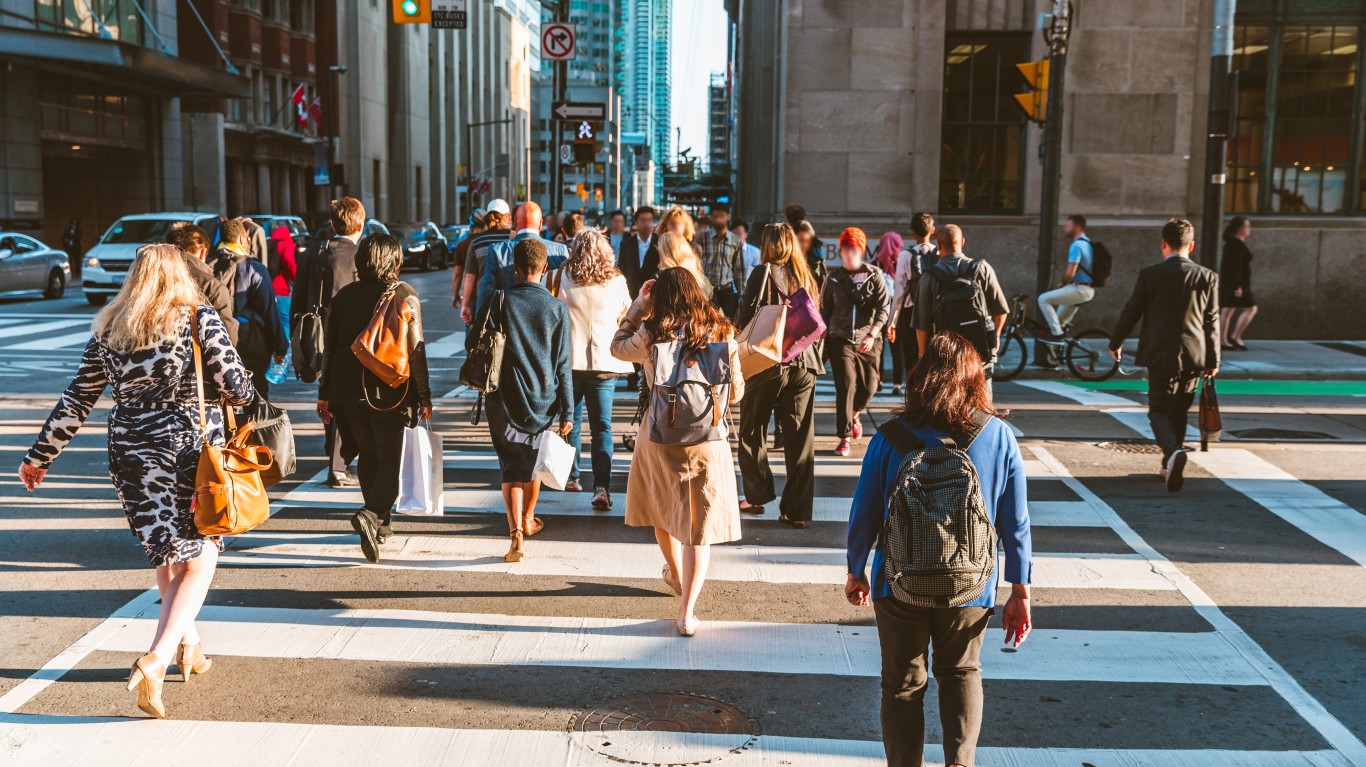Special Report
The Only Countries Where Most People Are Not Biased Against Women

Published:

Despite advancements in women’s rights, no country has achieved true gender parity, and the effects on women’s lives are quantifiable. The global gender gap in 2022 closed by 68.1%, according to the World Economic Forum Global Gender Gap Report 2022. At the current rate of progress, the report adds, it will take132 years to reach full parity. (Take a look at the U.S. metros with the worst pay gaps.)
A leading factor in the disparity between women’s and men’s income, health, education, and security is the existence of gender biases, including the beliefs that men make better business executives or that women should maintain the household rather than pursuing higher education. While biases exist throughout every nation and culture, some countries are far less biased against women than others.
To identify the countries least biased against women, 24/7 Tempo reviewed the 2023 Gender Social Norms Index from Human Development Reports, an annual report commissioned by the United Nations Development Programme released most years since 1990. Of the 91 countries with statistics on bias, 60 have been updated to the 2017-2022 survey period. We listed the seven countries in the latest survey where a majority of adult country residents have no gender bias. It is worth noting that Sweden and Norway, where a majority of residents reported no bias in 2010-2014 and 2005-2009, were excluded due to lack of updated survey data.
The GSNI attempts to quantify biases against women by capturing people’s attitudes on women’s roles in four key dimensions: political, educational, economic, and physical integrity. People were asked if they think “men make better political leaders than women;” if “university is more important for men than women;” or if “men should have more right to a job than women,” among other questions The report also measures intimate partner violence and reproductive rights biases.
The seven countries least biased against women are spread out between North America, Europe, and Oceania. In the six countries with gross national income data, women’s GNI per capita is between 61% and 73% of men’s GNI per capita, compared to 12% in Iraq, one of the countries most biased against women.
Some of these countries have been leaders in women’s equity, especially in politics. Most, including Germany, New Zealand, Canada, Australia, and the U.K., have had women heads of state. (Read about the most famous female rulers in history.)
Click here to see the 7 countries least biased towards women

7. Andorra
> Share of people with no gender bias: 57.5%
> Share with at least 1 bias against women: 42.5%
> Share with at least 2 biases against women: 15.5%
> Estimated GNI per capita, 2021 – women: N/A
> Estimated GNI per capita, 2021 – men: N/A
A tiny landlocked country in the Pyrenees between Spain and France, Andorra has a population of 79,034. In the country’s 2011 parliamentary election, Andorra became the first European nation to elect a majority female legislature.
[in-text-ad]

6. Canada
> Share of people with no gender bias: 58.9%
> Share with at least 1 bias against women: 41.1%
> Share with at least 2 biases against women: 20.7%
> Estimated GNI per capita, 2021 – women: $38,652 – #18 highest out of 190 countries
> Estimated GNI per capita, 2021 – men: $55,065 – #24 highest out of 190 countries
In 21st century Canada, a few women’s rights milestones include the appointment of a parliamentary task force to improve federal pay equity as well as a committee dedicated to promoting government action on gender equality. There is gender equality in the Canadian cabinet, with half the ministers men.

5. Germany
> Share of people with no gender bias: 62.6%
> Share with at least 1 bias against women: 37.4%
> Share with at least 2 biases against women: 13.3%
> Estimated GNI per capita, 2021 – women: $46,150 – #13 highest out of 190 countries
> Estimated GNI per capita, 2021 – men: $63,143 – #17 highest out of 190 countries
In 2005, Angela Merkel became Germany’s first female chancellor – a position she held onto for 16 years. In business, Germany has the third highest rate of women in the workforce compared to the rest of the EU. And in education, half of university graduates and 45% of doctoral students are women.

4. Australia
> Share of people with no gender bias: 65.2%
> Share with at least 1 bias against women: 34.8%
> Share with at least 2 biases against women: 15.4%
> Estimated GNI per capita, 2021 – women: $37,486 – #20 highest out of 190 countries
> Estimated GNI per capita, 2021 – men: $61,161 – #19 highest out of 190 countries
In 1921, Australia became among the first countries in the world to grant women the right to be elected to parliament, with social activist Edith Cowan winning a seat that year. Since then, women have held prominent positions in government including premier and prime minister.
[in-text-ad-2]

3. Netherlands
> Share of people with no gender bias: 69.4%
> Share with at least 1 bias against women: 30.6%
> Share with at least 2 biases against women: 11.2%
> Estimated GNI per capita, 2021 – women: $46,301 – #12 highest out of 190 countries
> Estimated GNI per capita, 2021 – men: $65,778 – #13 highest out of 190 countries
In January 2022, a record number of women made up the Dutch government coalition, as 14 of the 29 ministers and secretaries were women. In local elections later that year, 400 women won their seats, leading to the first instance of every municipality having at least one woman representative.

2. United Kingdom
> Share of people with no gender bias: 70.4%
> Share with at least 1 bias against women: 29.6%
> Share with at least 2 biases against women: 9.4%
> Estimated GNI per capita, 2021 – women: $37,374 – #21 highest out of 190 countries
> Estimated GNI per capita, 2021 – men: $53,265 – #28 highest out of 190 countries
In 1979, Margaret Thatcher became the first woman prime minister of the U.K., serving for 11 years until 1990. Since then, the U.K. has elected two more women prime ministers. In education, girls outperform boys in General Certificates of Secondary Education, and in 2013, women surpassed men in rates of degree-level qualifications.
[in-text-ad]

1. New Zealand
> Share of people with no gender bias: 72.6%
> Share with at least 1 bias against women: 27.4%
> Share with at least 2 biases against women: 8.7%
> Estimated GNI per capita, 2021 – women: $36,864 – #22 highest out of 190 countries
> Estimated GNI per capita, 2021 – men: $51,377 – #29 highest out of 190 countries
In 1893, New Zealand became the first country in the world to grant women the right to vote. In 1933, the first woman in the country was elected to parliament, and in 1997 Jenny Shipley became the first woman prime minister. More recently, Dame Jacinda Ardern was elected prime minister in 2017 and served until resigning her post in 2023.
The average American spends $17,274 on debit cards a year, and it’s a HUGE mistake. First, debit cards don’t have the same fraud protections as credit cards. Once your money is gone, it’s gone. But more importantly you can actually get something back from this spending every time you swipe.
Issuers are handing out wild bonuses right now. With some you can earn up to 5% back on every purchase. That’s like getting a 5% discount on everything you buy!
Our top pick is kind of hard to imagine. Not only does it pay up to 5% back, it also includes a $200 cash back reward in the first six months, a 0% intro APR, and…. $0 annual fee. It’s quite literally free money for any one that uses a card regularly. Click here to learn more!
Flywheel Publishing has partnered with CardRatings to provide coverage of credit card products. Flywheel Publishing and CardRatings may receive a commission from card issuers.
Thank you for reading! Have some feedback for us?
Contact the 24/7 Wall St. editorial team.